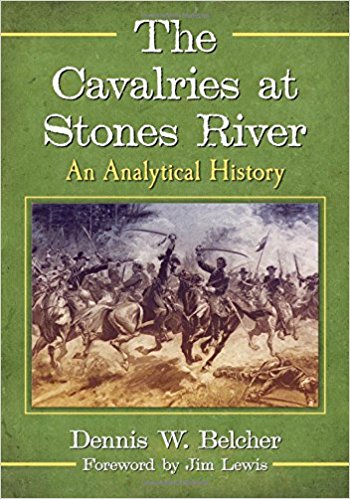The Cavalries at Stones River: An Analytical History by Dennis W. Belcher. McFarland & Company, Inc., 2017. Paper, ISBN: 978-1476665368. $39.95.
 The Battle of Stones River, fought from December 31, 1862, to January 2, 1863, might be the closest thing to a drawn battle in the entire American Civil War. Just after Christmas, Union Major General William S. Rosecrans led his Army of the Cumberland, 40,000 strong, out of their winter camps at Nashville, Tennessee, to assail Confederate General Braxton Bragg’s Army of Tennessee—35,000 strong—along the banks of Stones River, near Murfreesboro. Though Rosecrans was on the strategic offensive, Bragg was not a passive commander; when both armies came face-to-face on the battlefield, each planned an assault, but Bragg struck first.
The Battle of Stones River, fought from December 31, 1862, to January 2, 1863, might be the closest thing to a drawn battle in the entire American Civil War. Just after Christmas, Union Major General William S. Rosecrans led his Army of the Cumberland, 40,000 strong, out of their winter camps at Nashville, Tennessee, to assail Confederate General Braxton Bragg’s Army of Tennessee—35,000 strong—along the banks of Stones River, near Murfreesboro. Though Rosecrans was on the strategic offensive, Bragg was not a passive commander; when both armies came face-to-face on the battlefield, each planned an assault, but Bragg struck first.
That blow resulted in a daylong struggle on December 31, and though Bragg’s attack routed much of the Union right and nearly ran Rosecrans’s army off the field, the federals held on. A secondary Confederate attack launched on January 2 ended in a bloody repulse. Bragg subsequently retreated. Rosecrans claimed victory, though by any measure it was, as Lord Wellington said of Waterloo, “a near-run thing.”
The campaign was short, lasting less than two weeks. Though the heaviest fighting occurred on December 31 and January 2, each side’s cavalry experienced combat daily. In this welcome study of the Stones River campaign, historian Dennis Belcher focuses on the clash of cavalry over the entire span.
Belcher’s monograph is welcome for two reasons: first, while Civil War studies have extensively examined cavalry in the war’s eastern theater, much less effort has been devoted to mounted operations west of the Appalachians; second, Belcher brings a new level of interpretation to one of the war’s most desperate struggles, Stones River.
Bragg came very close to winning that battle, and if wars were scored on points, probably did do better than his opponent. Yet he retreated, leaving the field—and the victory, by however narrow a margin— to Rosecrans. Belcher argues that this was in part because, while the Confederate cavalry inflicted considerable damage on Rosecrans’s supply line, they did not sever it, leaving Bragg with little other option than to fall back. Bragg and Confederate Chief of Cavalry Joseph Wheeler both embraced a “raiding strategy,” which had, up to then, proven very successful in checking Union advances. Wheeler sought to duplicate that strategy on December 30, riding entirely around Rosecrans’s army, striking at his supply trains along the Nashville Pike. Wheeler did inflict considerable damage but, in the end, that raid had limited impact on the larger battle.
Belcher’s work begins with an extensive background section, exploring the state of both cavalries in the weeks prior to Stones River. He then takes readers systematically through the various actions of each side from December 26 onward. Though the author does not neglect preliminary actions, the heart of the work embraces the fighting on December 31 in detail. This is proper, because here we find one of the few examples of effective battlefield cavalry use in the entire Civil War: John Warton’s success in keeping pressure on the routed Union right wing, as well as federal efforts to check that effort and finally throw Wharton back.
Perhaps the most intriguing section is devoted to a reexamination of John S. Pegram’s role in the battle. Pegram, a rebel brigade commander supporting Bragg’s right, has long been blamed for poor scouting work. Belcher argues that this blame is undeserved, and that the surviving evidence paints a different picture. Unfortunately, Belcher offers up no new ‘smoking gun’ to defend Pegram, perhaps because the surviving documentary record is so sparse. He raises interesting questions, but few concrete answers.
Belcher’s other key point explains how the Union cavalry—outnumbered, and sometimes simply outfought—still managed a credible performance at Stones River, thanks largely to the organizational efforts of Rosecrans and especially David S. Stanley, Wheeler’s Union counterpart. Unquestionably, what they saw at Stones River spurred both Rosecrans and Stanley to make strengthening and improving the federal mounted arm a priority: all the better to be ready for the next time the Army of the Cumberland advanced to battle.
The Cavalries at Stones River delivers on the promise of its subtitle: An Analytical History. Solidly written and extensively researched, Belcher’s work is an excellent addition to both western theater cavalry studies and the specifics of the battle of Stones River. Though at $39.95 this paperback might seem expensive, the content more than delivers full value. I heartily recommend it.
David A. Powell is the author of The Chickamauga Campaign, a trilogy published by Savas Beatie.
